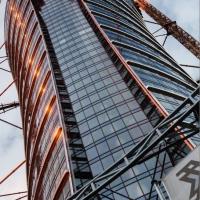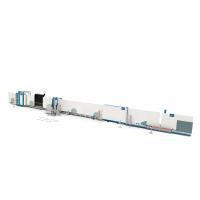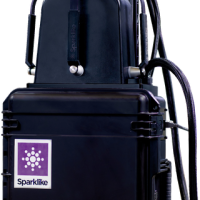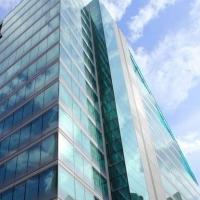What does “high strength” glass bonding mean?
In the façade industry, glass panes have been bonded to aluminium frames with UV-resistant silicone adhesives for 40 years with almost unchanged mechanical strength. But modern architecture now calls for slimmer, filigree metal frame work and bigger glass panes in complex free-form constructions, challenging the application limits of existing adhesive products.
Figure 1 shows the wide range of mechanical strength of adhesives and sealants currently available on the market. Polyurethane, acrylics and epoxy adhesives achieve easily a tensile strength of 10 - 30 N/mm2. Why aren’t they approved for structural sealant glazing in architecture?
.jpg)
Figure 1: Overview of adhesives and their mechanical strength
Click to enlarge
UserFiles/fig1(2).jpg
PU adhesives are commonly used in automotive windshield bonding. Because of their low UV stability they must be protected by a black screen print, not very suitable in architecture with so many different glass sizes and relatively small production series.
Acrylic adhesives are generally a bit more UV resistant but are mostly sensitive against high humidity, disqualifying this product group from structural sealant glazing. Epoxy adhesives have by far the lowest movement capability, not able to accommodate high thermal movements in the linear adhesive joints of big façade units.
Finally only the silicones are left over. Enough resistant to UV and humidity during a façade’s services life and sufficiently capable to accommodate the movements, high performance silicone adhesives are the only product group approved for structural sealant glazing by international guidelines (ETAG 002) [1] and standards (e.g. ASTM C1184) [2].
But figure 1 also shows the limited strength of silicones compared to other adhesives. Measured on H-specimens with the dimension of 12x12x50 mm, as described in ISO 8339 [3] and ASTM C1135 [4], structural glazing adhesive sealants reach 1.2 N/mm2 at a maximum.
These relatively low values must not be confused with the more than two times higher values for the same product measured on dumbbell specimens complying with ASTMD412.
But was there ever any improvement of the mechanical strength of silicones over the last few years or are there any developments in the pipeline? Yes, there are very recent developments of silicone adhesives with unseen mechanical strength. And they will for sure have an impact on traditional structural glazing façade constructions plus there will be benefits for other glass bonding applications, such as bonded metal fasteners and bomb blast glazing.
Argon-filled insulating glass in structural glazing facades
First let’s look back a decade. Due to energy saving regulations, today argon-filled IG units, sealed with polyurethane and polysulfide secondary sealants are state of the art in windows and have been promoted for more than 20 years. In structural glazing facades however, silicone sealants have to be used as insulating glass secondary sealants.

Figure 2: Stress-strain diagram of old and new silicone adhesive generation
Click to enlarge
UserFiles/fig2(1).jpg
Due to their high argon permeability it was at that time a quite common understanding that argon-filled IG units sealed with silicones were not suitable for SG facades. At the beginning of the new millennium the IG industry put more focus on the production process, especially on the butyl application [5]. Butyl as a primary seal is the main barrier against humidity penetration and argon loss.
First IG tests units complying with DIN1286-2 (replaced by EN 1279-3 in 2002) with argon loss rates below 1% p.a. were reported. But only the development of special IG secondary sealants with a significantly higher modulus at even short elongations made argon loss rates as low as 0.2 % p.a. feasible. This new generation of IG secondary sealants reduces the movement of the primary edge seal and minimises the risk of leakages in the butyl layers. With such a low argon loss rate, even after 30-years service life of IG units, an increase of the Ug value of less than 0.1% W/m2K can be expected [6].
Structural sealant glazing
These IG secondary sealants have a high modulus at low elongation. However, their limited maximum elongation is too short for wide use in structural sealant glazing with its high thermal movements in storey-high façade elements.
Now there are brand new developments in the pipeline of the sealant industry overcoming these disadvantages by doubling the mechanical strength of standard SG adhesives, thus reaching tensile strength of almost 2 N/ mm2 at approx. 100% elongation.
Already today you can find 1-part SG adhesives in the market with an SG design strength of 0.17 N/mm2 (acc. ETAG 002) for joint bite calculations.
As for 1-part silicone adhesives the maximum joint bite is limited to 15 – 18 mm they are unsuitable for really big SG units exposed to high loads. The new 2-part sealants will drive the design factor beyond 0.20 N/mm2 with considerable consequences. Figure 2 compares the stress-strain curves of a standard adhesive against the new generation.
First of all consequences to mention is the saving of material. A brief example to demonstrate the great saving potential: a project with a glass façade of 75000 m2 in a hurricane area with wind loads up to 7 kPa 91 t of standard SG adhesive would be required to fill a joint size of 36 x 12 mm. With the new adhesive, the joint size can be reduced to 18 x 6 mm, giving sealant consumption as low as 41 t. This means an overwhelming material saving of more than 50%.
Another aspect of material saving is related to the aluminium profile. In this example the aspect of the profile could be reduced by 24 mm per module. Slimmer profile cross sections are not just a rational saving aspect but also the requirement of modern architecture planning with more and more transparency.
Not just a remarkable saving of material is feasible with the new adhesive but also a saving of energy during the buildings’ operation time. Although silicone adhesives have a hundred times lower heat transfer coefficient than aluminium it is a matter of fact that air is an even better thermal insulator. Hence the smaller the joint bite the lower is the Uf value, the less energy gets lost. On top of that, with slimmer cross sections more light can penetrate the façade. This gives the additional bonus of energy gain/generation.
.jpg)
Figure 3: High-performance glass bonding at its limits: Breathing - a new sculpture for Broadcasting House, dedicated to the memory of journalists killed in the line of work
The same chain of argumentation – smaller frame aspect, lower Uf value, and energy gain - is applicable also on structurally bonded PVC windows, a new powerful trend in the window industry. Here the IG unit is bonded to the sash frame with a high strength adhesive (very often silicone).
The slim sash is stabilised by the IG unit and doesn’t even need a metal reinforcement. This reduces not only material but also production cost. Energy saving due to the much lower Uf value is an added value for the end user and the environment [7].
Outlook into related applications: bonded metal fasteners and bomb blast glazing What counts for linear bond lines is also applicable on punctual bonding. The higher the adhesive strength the smaller is the bonding area for metal fasteners. The application of the ETAG 002 rules (with its high safety factor of 6) on bonded metal fasteners results in huge, “unsexy” plates.
The memorial sculpture on top of the BBC Broadcasting House in London, designed by Jaume Plensa and inaugurated in 2008 by Secretary-General of the United Nations, Ban Ki-Moon, is a glass construction with curved glass panes held to the support structure with large bonded metal fasteners (see Fig. 3).
These plates could be reduced now to much more attractive fasteners and would visually merge with the grey metal frame. The optimisation of bonded metal fasteners is a hot subject of many universities and private research groups. A lot of work has been published e.g. by B. Weller about dynamic behaviour of adhesives [8] and by A. Hagl on the influence of the shape of the plates and the bonding dimensions [9]. These new adhesives may give those developments an unprecedented push.
A new chapter may also be written for bomb blast glazing where glass and adhesive have to withstand ultimate stress. At blasts the tensile strength of the adhesive is more than tripled due to the high impact speed. In tests with standard adhesives the max. tensile strength reached a level of 3.3 N/mm2 at a 60’000 times higher test speed of 5 m/s compared to a tensile strength of 1.0 N/mm2 measured with standard low speed test methods (5 mm/min acc. ISO 8339).
An even higher test speed may give a higher tensile strength but this is not applicable to the bomb blast reality as the glass pane can react to the impact at a maximum speed of about 4 m/s (depending on the glass type). High speed tests with the new material simulating bomb blasts are under way and values of more than 6 N/ mm2 can be expected.
SUMMARY
The first test results with this very young development have shown its huge potential for:
- Designers - more transparency, more freedom of design
- Fabricators - material saving, cost saving
- Owners - energy saving, cost saving and make us curious for more. After more comprehensive tests and with more knowledge about the material’s limits the high-strength adhesive will certainly get access into cold bent glass constructions, hybrid glass beams, and total vision glazing lobbies with ultra-thin glass fins.
REFERENCES
[1] EOTA (European Organisation for Technical Approvals), ETAG 002, Guideline for European Technical Approval for Structural Sealant Glazing Systems, Brussels, 1999 and amendment 2001
[2] ASTM C1184 - 05 Standard Specifications for Structural Silicone Sealants
[3] ISO 8339 (2005) Building Construction - Sealants - Determination of tensile properties (Extension to break)
[4] ASTM C1135 - (2005) Standard Test Method for Determining Tensile Adhesion Properties of Structural Sealants
[5] Isolar Glas-Beratungs-GmbH: Qualität macht’s möglich: UV-stabiler Randverbund mit Gasfüllung. In GFF – Zeitschrift für Glas, Fenster und Fassade (p. 43, 12/2001)
[6] Wagner W.; Müller U.: Russia Federation Towers - A structural glazing façade at the highest stage of energy saving. In: Proceedings; Glass Performance Days 2007; Tampere 2007
[7] Aagerter S.; Wagner W.; Window Technology - quo vadis? Intelligent Glass Solutions 01/2008
[8] Weller, B.; Nicklisch, F.; Wünsch, J.: Dynamic Behaviour of Adhesives for Structural Glass Applications. In: Proceedings; Glass Performance Days 2009; Tampere 2009
[9] A. Hagl: Understanding Complex Adhesive Behaviour: Case Study U-type Bonding Geometry, Proceedings of "Challenging Glass 2 - Conference on Architectural and Structural Applications of Glass", Bos, Louter, Veer (Eds.), TU Delft, May 2010.
AUTHOR: Dr Werner Wagner, Sika Services AG
First published in Intelligent Glass Solutions issue 2.2011





















